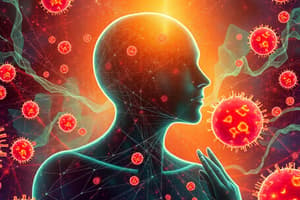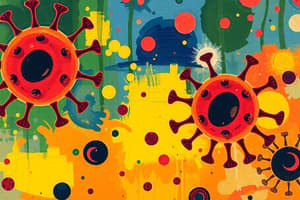Podcast
Questions and Answers
What are the symptoms associated with insect allergies?
What are the symptoms associated with insect allergies?
- Rashes and itching
- Localized swelling and anaphylaxis (correct)
- Sneezing and nasal congestion
- Gastrointestinal issues and hives
Which type of allergy is triggered by airborne allergens?
Which type of allergy is triggered by airborne allergens?
- Skin allergies
- Food allergies
- Medication allergies
- Respiratory allergies (correct)
Which allergen is a common cause of asthma and allergic rhinitis?
Which allergen is a common cause of asthma and allergic rhinitis?
- Shellfish
- Pet dander (correct)
- Latex
- Mold
Which of the following is NOT considered a common food allergen?
Which of the following is NOT considered a common food allergen?
Which type of allergy is primarily related to immune responses triggered by food proteins?
Which type of allergy is primarily related to immune responses triggered by food proteins?
What symptom is commonly associated with insect allergies?
What symptom is commonly associated with insect allergies?
Which allergen is linked to seasonal allergic reactions, often referred to as hay fever?
Which allergen is linked to seasonal allergic reactions, often referred to as hay fever?
What common trigger for skin allergies can also be found in personal care products?
What common trigger for skin allergies can also be found in personal care products?
Which of the following is a common cause of respiratory allergies?
Which of the following is a common cause of respiratory allergies?
Flashcards are hidden until you start studying
Study Notes
Types of Allergies
-
Food Allergies
- Reactions to specific foods (e.g., nuts, shellfish, dairy).
- Symptoms: hives, gastrointestinal issues, anaphylaxis.
-
Respiratory Allergies
- Triggered by airborne allergens (e.g., pollen, dust mites, pet dander).
- Symptoms: sneezing, nasal congestion, asthma.
-
Skin Allergies
- Contact with allergens causing dermatitis (e.g., latex, certain metals).
- Symptoms: rashes, itching, swelling.
-
Insect Allergies
- Reactions to insect stings or bites (e.g., bees, wasps).
- Symptoms: localized swelling, anaphylaxis in severe cases.
-
Medication Allergies
- Caused by reactions to certain medications (e.g., penicillin).
- Symptoms: rash, difficulty breathing, swelling.
-
Environmental Allergies
- Triggered by environmental factors (e.g., mold, smoke).
- Symptoms: respiratory issues, skin irritation.
Common Allergens
-
Pollen
- From trees, grasses, and weeds.
- Seasonal trigger for hay fever.
-
Dust Mites
- Microorganisms in household dust.
- Common cause of asthma and allergic rhinitis.
-
Pet Dander
- Skin flakes from animals (cats, dogs).
- Can trigger respiratory allergies.
-
Mold
- Fungi that grow in damp areas.
- Can cause respiratory issues and skin reactions.
-
Foods
- Common allergens include:
- Peanuts
- Tree nuts
- Shellfish
- Eggs
- Dairy
- Wheat
- Soy
- Common allergens include:
-
Insect Venom
- From stings of insects like bees and wasps.
-
Latex
- Found in gloves, balloons, and some medical supplies.
- Can cause skin reactions and respiratory issues.
Types of Allergies
- Food Allergies: Triggered by specific foods such as nuts, shellfish, and dairy; symptoms can include hives, gastrointestinal distress, and life-threatening anaphylaxis.
- Respiratory Allergies: Caused by inhaled allergens like pollen, dust mites, and pet dander; symptoms include sneezing, nasal congestion, and asthma attacks.
- Skin Allergies: Result from contact with allergens that may cause dermatitis; common allergens include latex and certain metals, leading to rashes, itching, and swelling.
- Insect Allergies: Occur due to stings or bites from insects, such as bees and wasps; symptoms typically include localized swelling, with potential for severe anaphylactic reactions.
- Medication Allergies: Triggered by specific medications like penicillin; symptoms often manifest as rashes, difficulty breathing, and swelling.
- Environmental Allergies: Induced by factors in the environment such as mold and smoke; symptoms can lead to respiratory issues and skin irritations.
Common Allergens
- Pollen: Derived from trees, grasses, and weeds; it is a seasonal trigger for allergic reactions such as hay fever.
- Dust Mites: Tiny organisms found in household dust; a significant contributor to asthma and allergic rhinitis.
- Pet Dander: Skin flakes from animals like cats and dogs; exposure can provoke respiratory allergies in sensitive individuals.
- Mold: Types of fungi that thrive in moist conditions; can lead to respiratory problems and skin reactions upon exposure.
- Foods: Common food allergens include peanuts, tree nuts, shellfish, eggs, dairy, wheat, and soy; these can provoke allergic reactions in susceptible individuals.
- Insect Venom: Allergic reactions can stem from the venom of stings from insects such as bees and wasps.
- Latex: A common component in gloves, balloons, and medical supplies; known to cause skin disorders and respiratory issues in allergic individuals.
Types of Allergies
- Respiratory Allergies: Triggered by airborne substances; symptoms include sneezing, nasal congestion, and itchy eyes; common allergens are pollen, dust mites, mold, and pet dander.
- Food Allergies: Result from an immune response to specific food proteins; symptoms can manifest as hives, swelling, or gastrointestinal distress; common allergens include milk, eggs, peanuts, tree nuts, fish, shellfish, soy, and wheat.
- Skin Allergies: Reactions that manifest on the skin; typical symptoms include rashes, itching, and hives; common triggers include poison ivy, latex, fragrances, and certain metals.
- Insect Allergies: Caused by reactions to insect venom or bites; symptoms may range from pain and swelling to anaphylaxis in severe cases; common triggers involve bee, wasp, and fire ant stings.
- Drug Allergies: Immune responses to medications; symptoms can include rashes, respiratory issues, and anaphylaxis; common triggers are penicillin, aspirin, and certain vaccines.
Common Allergens
- Pollen: Released by trees, grasses, and weeds; primarily associated with seasonal allergies, known as hay fever.
- Dust Mites: Microscopic organisms prevalent in bedding and carpets; significant triggers for asthma and respiratory allergies.
- Mold: Fungi that thrive in damp settings; capable of growing both indoors and outdoors.
- Animal Dander: Composed of skin flakes, saliva, and urine from pets; often found in homes with cats and dogs.
- Food Products: Includes common allergens like cow's milk, eggs, peanuts, tree nuts, soy, wheat, fish, and shellfish.
- Insect Venom: Venom from stinging insects, notably bees and wasps.
- Latex: Present in rubber gloves, balloons, and certain medical devices; can cause allergic reactions.
- Fragrances: Frequently found in personal care items; can precipitate skin or respiratory allergies.
Studying That Suits You
Use AI to generate personalized quizzes and flashcards to suit your learning preferences.




